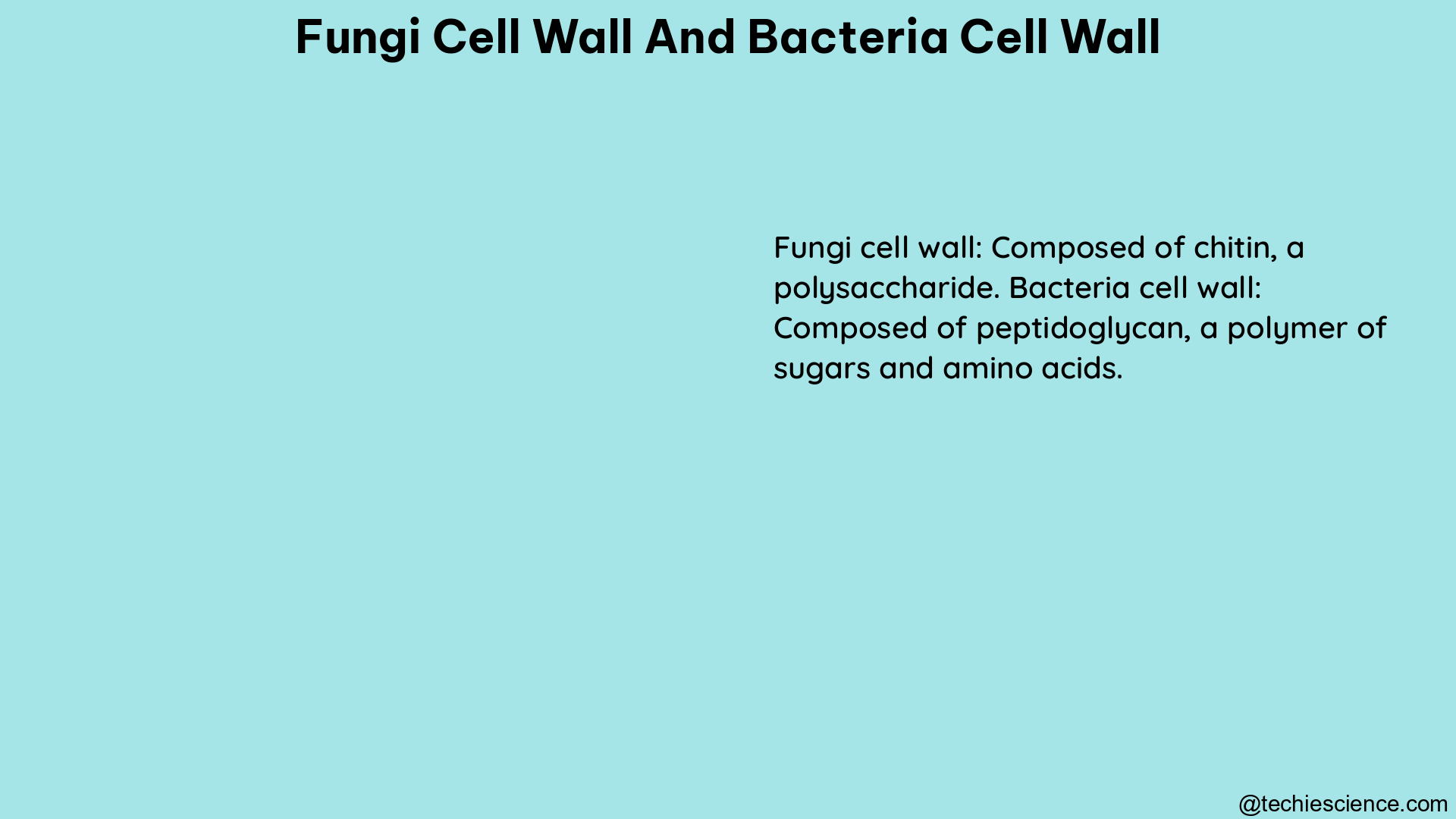The fungal cell wall is a complex and dynamic structure that plays a crucial role in protecting the cell against osmotic pressure, providing mechanical support, and determining the cell shape. The bacterial cell wall, on the other hand, is composed of peptidoglycan, a polymer of sugars and amino acids that provides structural support and protection against osmotic pressure. Understanding the intricate details of these cell walls is essential for various applications, from drug development to microbial ecology.
Fungal Cell Wall: Structure and Composition
The fungal cell wall is primarily composed of polysaccharides, including chitin, β-glucans, α-glucans, and mannoproteins, which are arranged in a two-domain distribution.
Inner Domain
The inner domain of the fungal cell wall is composed of α-1,3-glucan and chitin, which form a rigid and hydrophobic core. This core is embedded in a well-hydrated and relatively mobile matrix of β-1,3-, β-1,4-, and β-1,6-glucans.
- Chitin: Chitin is a linear polymer of N-acetylglucosamine (GlcNAc) units linked by β-1,4 glycosidic bonds. It is a major structural component of the fungal cell wall, providing rigidity and strength.
- α-1,3-Glucan: This polysaccharide is also a crucial component of the inner domain, contributing to the cell wall’s rigidity and hydrophobicity.
Outer Shell
The outer shell of the fungal cell wall is formed by mannoproteins and α-1,3-glucan, which are extremely mobile.
- Mannoproteins: These glycoproteins are composed of a protein backbone with highly branched mannan side chains. They play a role in cell wall permeability, adhesion, and immune recognition.
- α-1,3-Glucan: This polysaccharide, in addition to its presence in the inner domain, also contributes to the outer shell, providing flexibility and protection.
Molecular Architecture Revealed by Solid-state NMR
Solid-state NMR spectroscopy, assisted by dynamic nuclear polarization and glycosyl linkage analysis, has provided a high-resolution model of the fungal cell wall architecture. This technique has revealed the following insights:
- Chitin and α-1,3-glucan build a hydrophobic scaffold that is surrounded by a hydrated matrix of diversely linked β-glucans.
- The outer shell is capped by a dynamic layer of glycoproteins and α-1,3-glucan.
- The two-domain distribution of α-1,3-glucans signifies their dual functions: contributing to cell wall rigidity and fungal virulence.
These findings have allowed for the development of a non-destructive method for determining the architecture of fungal cell walls, which can be used to assess drug response and promote the development of wall-targeted antifungals.
Bacterial Cell Wall: Structure and Composition

Bacterial cell walls are composed of peptidoglycan, a polymer of sugars and amino acids that provides structural support and protection against osmotic pressure. The thickness and composition of the peptidoglycan layer vary among bacterial species, with Gram-positive bacteria having a thicker layer than Gram-negative bacteria.
Gram-positive Bacteria
Gram-positive bacteria have a single layer of peptidoglycan that is surrounded by a thick layer of teichoic acids.
- Peptidoglycan: The peptidoglycan layer in Gram-positive bacteria is composed of alternating N-acetylglucosamine (GlcNAc) and N-acetylmuramic acid (MurNAc) units linked by β-1,4 glycosidic bonds. These units are cross-linked by short peptide chains, providing structural integrity.
- Teichoic Acids: These are anionic polymers that are covalently linked to the peptidoglycan layer or anchored to the underlying cell membrane. Teichoic acids play a role in maintaining cell shape, regulating autolytic enzymes, and facilitating the attachment of proteins to the cell wall.
Gram-negative Bacteria
Gram-negative bacteria have a thin layer of peptidoglycan that is surrounded by an outer membrane containing lipopolysaccharides.
- Peptidoglycan: The peptidoglycan layer in Gram-negative bacteria is thinner than in Gram-positive bacteria, but it still provides structural support and protection against osmotic pressure.
- Outer Membrane: The outer membrane of Gram-negative bacteria is composed of lipopolysaccharides (LPS), which are large molecules consisting of a lipid component (lipid A) and a polysaccharide component. The outer membrane acts as a permeability barrier, protecting the cell from various environmental stresses and antimicrobial agents.
Molecular Structure Revealed by X-ray Diffraction and Electron Microscopy
The molecular structure of bacterial cell walls has been studied using X-ray diffraction and electron microscopy, which have revealed the following:
- The presence of a rigid peptidoglycan layer in both Gram-positive and Gram-negative bacteria.
- The existence of a flexible outer membrane in Gram-negative bacteria, which is absent in Gram-positive bacteria.
- The detailed arrangement and cross-linking of the peptidoglycan units, providing structural integrity to the cell wall.
These techniques have been instrumental in understanding the molecular architecture of bacterial cell walls, which is crucial for developing targeted antimicrobial strategies and studying the role of the cell wall in bacterial physiology and pathogenesis.
Conclusion
The fungal cell wall and bacterial cell wall are complex and dynamic structures that play crucial roles in the survival and function of their respective organisms. Understanding the intricate details of these cell walls, from their composition to their molecular architecture, is essential for various applications, including drug development, microbial ecology, and biotechnology. The advancements in analytical techniques, such as solid-state NMR spectroscopy, X-ray diffraction, and electron microscopy, have provided unprecedented insights into the structure and function of these cell walls, paving the way for further research and innovation.
References
- Molecular architecture of fungal cell walls revealed by solid-state NMR. https://www.ncbi.nlm.nih.gov/pmc/articles/PMC6048167/
- The cell wall of bacteria. https://www.sciencedirect.com/topics/biochemistry-genetics-and-molecular-biology/bacterial-cell-wall
- The Fungal Cell Wall: Structure, Biosynthesis, and Function. https://journals.asm.org/doi/10.1128/microbiolspec.funk-0035-2016
- Fungal Cell Wall: Structure, Biosynthesis, and Function. https://www.ncbi.nlm.nih.gov/pmc/articles/PMC6048167/
- Bacterial Cell Wall: Composition and Structure. https://www.sciencedirect.com/topics/biochemistry-genetics-and-molecular-biology/bacterial-cell-wall

Hi, I am Saif Ali. I obtained my Master’s degree in Microbiology and have one year of research experience in water microbiology from National Institute of Hydrology, Roorkee. Antibiotic resistant microorganisms and soil bacteria, particularly PGPR, are my areas of interest and expertise. Currently, I’m focused on developing antibiotic alternatives. I’m always trying to discover new things from my surroundings. My goal is to provide readers with easy-to-understand microbiology articles.
If you have a bug, treat it with caution and avoid using antibiotics to combat SUPERBUGS.
Let’s connect via LinkedIn: